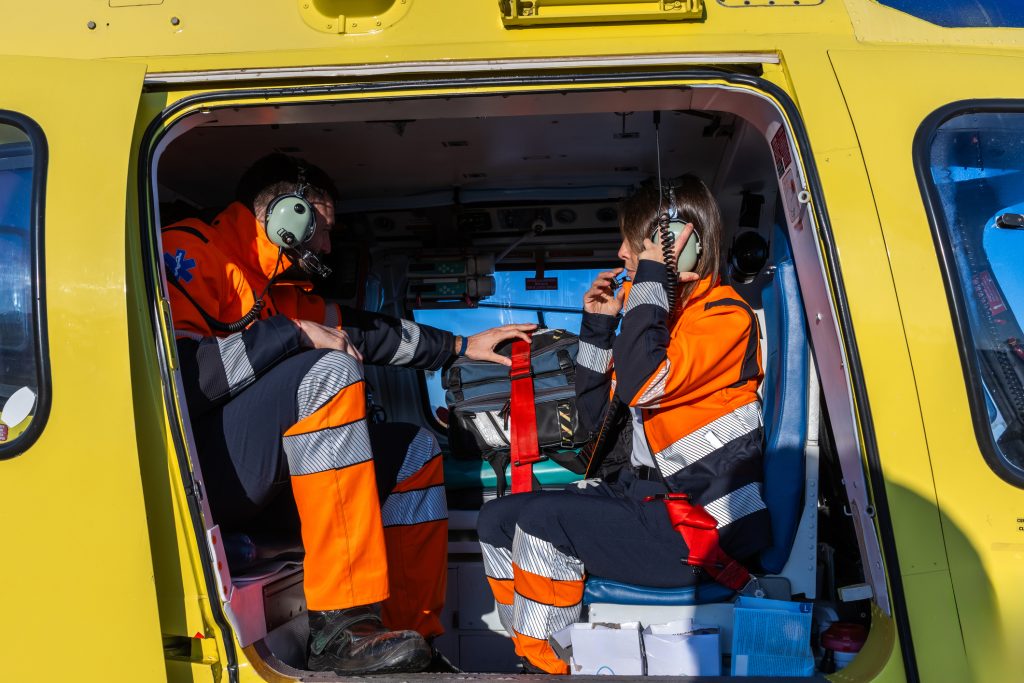Course
All About Flight Nursing
Course Highlights
- In this All About Flight Nursing course, we will learn about what the specialty of flight nursing entails in terms of education, experience, and personal attributes.
- You’ll also learn the job opportunities for flight nurses and where to find more information.
- You’ll leave this course with a broader understanding the role of a flight nurse to that of emergency department (ED) and intensive care unit (ICU) nurses.
About
Contact Hours Awarded: 1
Author: Marybeth Anderson Keppler, RN, BSN, M.Ed, OCN
Begin Now
Read Course | Complete Survey | Claim Credit
➀ Read and Learn
The following course content
Introduction
Perhaps you have seen or heard about flight nurses and their colleagues. This could be from real-life exposure, a television show or movie, or through stories from other nurses. Flight nurses are thought to be seekers of adventure and adrenaline, though many in the nursing field are not aware of the vast skills and responsibilities this role requires. In this course, you will learn about the various facets of flight nursing and see if the topic interests you.

Self-Quiz
Ask Yourself...
- Do you know any flight nurses, or have you seen any in your nursing experience?
- How would you describe the role of a flight nurse to someone unfamiliar?
- What credentials, education, and expertise do flight nurses need to be successful?
Definitions
The title flight nurse falls under the more extensive critical care transport (CCT) nurse umbrella. Patient transport, in general, usually involves one or more of the following modalities: ground (ambulance), air (fixed wing [airplane] or rotor [helicopter]), or water (boats). Most CCT nurses in the United States work on the ground, in the air, or a combination of the two. In all cases, the nurse works with a team: a driver or pilot and others like paramedics, fellow nurses, advanced providers, and/or physicians. In many situations, the nurse may be in a vehicle without a physician or advanced practice provider and would then be responsible for immediate decision-making of the treatment of critically ill patients.
Critical care transport nurses accompany patients from one destination to another, ensuring the person’s medical stability during the entire transfer (1, 2). This involves ongoing assessment and intervention using the nursing process and advanced nursing skills like intubation, inserting chest tubes and central lines, and titrating critical medications (2, 3).
As the title suggests, flight nurses work in the air. They perform their duties on helicopters and/or fixed-wing aircraft (3). These can include civilian, commercial, or military vessels, though all nurses are rigorously trained in critical care and patient stabilization.


Self-Quiz
Ask Yourself...
- How would you define a critical care transport nurse?
- What unique qualities do you think a CCT nurse needs to have?
- What other requirements or characteristics would make a CCT nurse a good fit to be a flight nurse?
- In what situations would a flight nurse be needed?
- Why might people pursue CCT/flight nursing?
Job Role and Work Conditions
As might be expected, the role of a flight nurse is highly variable and time-sensitive. Flight nurses are generally expected to do any or all of the following on any given shift (1,2):
- Assess patients thoroughly and reassess as their condition changes
- Check all equipment before departure and in transit
- Communicate clearly with team members in a loud, stressful, contained environment
- Document all interventions, including time and personnel involved
- Intervene with lifesaving measures as needed; this may include:
- CPR
- Insertion of chest tubes, central lines, or advanced airways
- Titration of medications like vasopressors, inotropes, or sedatives
- Monitoring life support equipment, such as:
- Cardiac monitors
- Chest tube drainage devices
- Defibrillators
- Temperature regulators
- Ventilators
- Transport people in the following situations:
- From car accidents or disasters to hospitals
- From a remote area to a medical facility
- In between medical facilities
Work conditions vary greatly, depending on the area’s temperature, climate, and resources. Flight nurses provide the same level of care received in ICUs and EDs but at high elevations and in motion.
In some cases, flight nurses may be involved in search-and-rescue missions, where several unpredictable factors may occur.

Self-Quiz
Ask Yourself...
- What would you expect a shift to look like for a flight nurse?
- What equipment might a flight nurse use on any given shift?
- What general and specific skills should a flight nurse possess?
Education
Flight nursing requirements start with the registered nurse (RN) licensure itself. Some agencies may require a Bachelor of Nursing (BSN) degree, but that varies by location. All flight nursing positions require emergency or critical care experience, with a preference for candidates who have both, and for a minimum of 2-5 years, depending on the organization.
Additional professional certification requirements generally include some or all of the following (4, 5):
- ACLS/ALS (Advanced Cardiac Life Support/ Advanced Life Support)
- CCRN (Critical Care Registered Nurse)
- CEN (Certified Emergency Nurse)
- CFRN (Certified Flight Registered Nurse)
- CTRN (Certified Transport Registered Nuse)
- NRP (Neonatal Resuscitation Program)
- PALS (Pediatric Advanced Life Support)
- A nationally recognized trauma certification or program completion, such as TCRN, TNCC, or TPATC (Trauma Certified Registered Nurse; Trauma Nursing Core Course; Transport Nurse Advanced Trauma Course)
Some organizations may also require certification as an emergency medical technician (EMT), whether at the introductory or paramedic level (5).
During one’s career as a flight nurse, other educational requirements will almost certainly be added: Flight safety, radio communication, ongoing technological updates, and other industry standards (8).


Self-Quiz
Ask Yourself...
- Do you currently have any of the above certifications applicable to flight nursing?
- To what professional nursing organizations do you belong, if any?
- What relevant experience or credentials do you have that might translate easily into flight nursing?
Experience
As mentioned above, it is best for nurses to have 3-5 years of experience in either the emergency department (ED), intensive care unit (ICU), or both. This is because flight nursing involves some of the fast-paced nature of work similar to ED and the ongoing management of ventilators and other equipment often used in ICU settings. Generally, from the beginning of nursing school to becoming a flight nurse takes at least 6-10 years (3, 4, 6).
Since 1980, the Air & Surface Transport Nurse Association (ASTNA) has aimed to enhance the quality of patient care and advance the practice of transport nursing (5). The ASTNA recommends at least 2-3 years of experience in acute care, emergency, and/or ICU settings. Similarly, the Association of Air Medical Services (AAMS), established in 1980, states that flight nurses should have at least 3 years of ICU or ED experience (7, 8).
Mini Case Study:
You are an experienced flight nurse with several years under your belt. You have been transporting critical care patients on the ground for two years and have just added fixed and rotor wings to your areas of expertise. One of your friends from nursing school is considering switching from six years of home health care nursing to flight nursing. They ask many questions about your current position, and you answer accordingly. Think about how you would respond to the following questions posed by your friend:

Self-Quiz
Ask Yourself...
- What education do I need to become a flight nurse?
- Should I leave home health nursing to get more experience before applying?
- What certifications are good to have for flight nursing?
- What else should I do to prepare myself for this new specialty?
- Any advice for an experienced nurse transitioning roles?
Personal and Professional Characteristics
Like other nursing specialties, flight nursing is not for everyone. Those wishing to pursue this career path should have most of the following personal qualities (3, 4, 5, 6, 7, 9):
- Ability to work comfortably in a confined space for hours at a time
- Ability to work in a loud environment
- Calm in the face of potentially dangerous, hazardous, or unstable situations
- Comfort being in the air for long periods
- Comfort with all age groups
- Fast, clear thinking under pressure
- Good situational awareness
- Interest and knowledge in the following areas:
- Aircraft, especially rotor, and fixed-wing
- Aviation safety
- Communications, primarily radio
- Critical care medicine
- Emergency medical care
- Trauma patient care
Professionally, those aspiring to be flight nurses should possess the following traits (5, 7, 8):
- Ability to develop a proactive plan of care for critically ill patients
- Ability to work independently, often without a physician present
- Accurate, rapid assessment and reassessment skills
- Comfort with the following critically ill populations:
- Elderly
- Infants
- Neonates
- Pregnant and postpartum people
- Good clinical judgment and critical thinking
- Good leadership skills
- Strong communication skills in a loud environment
- Strong mathematic capabilities, especially when titrating critical care medications
Extra Resources
More and more, flight nursing is gaining credence as a nursing specialty that is not going anywhere. It is a unique overlap of transport, critical care, and emergency nursing, and thus is governed and regulated by many organizations. The bright side is that each organization has resources for flight nurses. These include, but are not limited to, the following (5, 8, 9):
- AACN: American Association of Critical Care Nurses: This organization supports current and future critical care nurses with education, certification, and networking opportunities. https://www.aacn.org/
- AAMS: Association of Air Medical Services. More information about this course is above. https://aams.org
- ASTANA: Air & Surface Transport Nurses Association. More information about this course is above. https://astna.org
- BCEN: Board of Certification for Emergency Nursing: This organization has information on the most relevant flight nursing certifications, including CEN, CFRN, CTRN, TTNC, and more. https://bcen.org/
- ENA: Emergency Nurses Association: Another organization geared towards the professional development and networking of emergency nurses. https://www.ena.org/
- IAMTC: International Association of Medical Transport Communication Specialists: Aims to standardize the profession internationally, particularly in communications. www.iamtcs.org
Finally, the best bet for any nurse considering a specialty is networking and/or shadowing. Some ways to get a foot in the door with flight nursing are to visit bases, talk to current flight nurses and/or other critical transport professionals, and meet with those who hire these professionals (10). A combination of shadowing and networking can open up many opportunities for those considering this field.

Conclusion
Flight nursing involves a combination of personal and professional skills and qualities. While it is not a specialty for everyone, it can be gratifying and exciting for the right people. There are many resources and organizations for anyone interested in this career path. Even though it might take half a decade or more to become a flight nurse, it’s worth the wait for many.
References + Disclaimer
- Hartt, N. (2023, November 9). What is a critical care transport nurse? A look at this high-adrenaline role.
- https://www.rasmussen.edu/degrees/nursing/blog/what-is-a-critical-care-transport-nurse/
- Gaines, K. (2024, July 23). Critical care transport nurse career & salary guide. Nurse.org. https://nurse.org/resources/critical-care-transport-nurse/
- Mesrobian, C. (2021, November 8). Flight nursing: Exploring a sky-high job for the adventurous nurse. https://www.rasmussen.edu/degrees/nursing/blog/flight-nursing/
- Lambrych, M. (2024, May 24). How to Become a Flight Nurse. Nursejournal.org. https://nursejournal.org/careers/flight-nurse/how-to-become/
- Air & Transport Nurse Association. (n.d.). FAQs. Air & Surface Transport Nurses Association. https://www.astna.org/page/FAQs
- Burger, C. (2024, August 20). Flight/transport nurse. https://www.registerednursing.org/specialty/flight-nurse/
- Association of Air Medical Services. (n.d.). About us. https://aams.org/page/about
- Association of Air Medical Services. (2004). Guidelines for Air Medical Crew Education. https://cdn.ymaws.com/aams.org/resource/resmgr/aams_airmedicalcreweduc_1_.pdf
- Purdom, S. (n.d.). Flight nursing 101. https://cdn.ymaws.com/www.astna.org/resource/resmgr/00Flight_Nursing_101.pdf
- Suzadail, S., & Moss II, E. (2024, November 5). How we became flight nurses: Flight nursing 101. Nurse.org. https://nurse.org/articles/flight-nurse-career-path/
Disclaimer:
Use of Course Content. The courses provided by NCC are based on industry knowledge and input from professional nurses, experts, practitioners, and other individuals and institutions. The information presented in this course is intended solely for the use of healthcare professionals taking this course, for credit, from NCC. The information is designed to assist healthcare professionals, including nurses, in addressing issues associated with healthcare. The information provided in this course is general in nature and is not designed to address any specific situation. This publication in no way absolves facilities of their responsibility for the appropriate orientation of healthcare professionals. Hospitals or other organizations using this publication as a part of their own orientation processes should review the contents of this publication to ensure accuracy and compliance before using this publication. Knowledge, procedures or insight gained from the Student in the course of taking classes provided by NCC may be used at the Student’s discretion during their course of work or otherwise in a professional capacity. The Student understands and agrees that NCC shall not be held liable for any acts, errors, advice or omissions provided by the Student based on knowledge or advice acquired by NCC. The Student is solely responsible for his/her own actions, even if information and/or education was acquired from a NCC course pertaining to that action or actions. By clicking “complete” you are agreeing to these terms of use.
➁ Complete Survey
Give us your thoughts and feedback
➂ Click Complete
To receive your certificate
